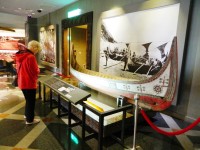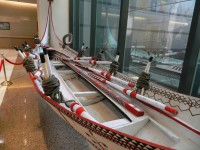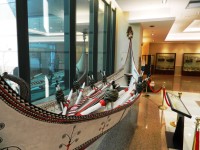We are very pleased to have a guest post from Joan Druett, who recently visited Taiwan. Joan is the multi-award winning author of more than 20 books, including her latest, Lady Castaways and Eleanor’s Odyssey.
A priority for anyone from the Pacific who visits Taiwan is the Shung-Ye Museum of Formosan Aborigines. After all, it is now both scientifically and popularly believed that the greatest migration of seafarers in history — the discovery and settlement of the islands of the Pacific — began in Taiwan. It was from the east coast of this mountainous island off the coast of mainland China that the people we now call Polynesians set out on their epic voyages. Our New Zealand Maori are distant cousins of the Formosan Aborigines, with a great deal in common, both in appearance and in personality. There are echoes of the local language in Maori te reo.
So here I am, gazing at a local canoe with some bemusement. Called a “balangay, it is not a canoe at all. As you can see from the following photos, taken at the marvelous Evergreen Maritime Museum in Taipei, a balangay is equipped with what could be called “row locks,” and is equipped with oars. The crew sit on small spreaders, or thwarts, and row in what we think of as the European fashion. It is not built on a dug-out keel, but entirely planked. There is not a single piece of metal in the carvel-built craft. The planks are fixed with wooden pins, and rope — probably sennit, originally — secures the rest.
These are fascinating craft. I had the privilege of meeting Syaman Rapongan, a native of Lan Yu (Orchid) Island, an islet off the southeast coast that is inhabited by his people, the Yami. As he says, building fishing boats is the most important craft of the Yami people, being essential for survival and livelihood, and also a way of proving one’s manhood. For a Yami youth, building his first canoe is a rite of passage.
Syaman Rapongan had his father as his mentor. Together, as he wrote, they went into the hills to choose and cut the fourteen different trees that each provide a part of the craft. The trees have names — Apnorwa, Isis, Pangohen, Cyayi. Each one provides timber for a certain part of the hull. Cyayi provided the keel.
Syaman’s father first prayed to the tree, and then said more prayers as he cut into the trunk. He says, “Trees are the children of the mountains. Boats are the grandchildren of the sea.” It is especially important to come to terms with the spirits of the hills during the felling of that first tree, for the keel of the boat. Then the cutting of the next 13 trees follows. The wood is cut into planks of three or four centimeters in width, of varying curves and shapes, and then everything is brought down from the hills to the beach, where the boat is assembled.
The decorations, I gathered, are equally traditional, each village having its own patterns. Final decorations are the rooster tails at the prow and stern, made of real feathers.
But what are they like in the water? Syaman Rapongan has some hair-raising tales of sudden storms, and overwhelming waves, of long hours where his crew rowed like madmen, only to get nowhere. So, were balangay anything like the craft in which the first voyagers set out at the start of the great migration, five thousand years ago?
Very unlikely, says Liao Hong-Ji, the founder of the Kuroshio Ocean Educational Foundation. Through an interpreter, he theorized that it was most likely a drift voyage, perhaps on a raft. The Kuroshio (Japan) Current flows past eastern Taiwan at different rates according to the season of the year. There are variations according to the moon, as well. From the hills, the current looks like a twisting river. But, at the right season, a man could drift to the Philippines on the breast of it, he said. And in fact, he went on with a serene smile, he is going to try it this year. By himself, on a solitary drift voyage.




I do not know about possible countercurrents, but it is not the Kuroshio that would allow a drift voyage from Taiwan to the Philippines. The Kuroshio begins off the east coast of Taiwan and flows northeastward past Japan, where it merges with the easterly drift of the North Pacific Current. It is part of the clockwise N Pacific gyre.
Yes, I asked Mr Liao about this, and he said that yes, the flow it toward Japan, but between April and July the current goes the other way past the eastern coast of Taiwan. He seemed confident. I suppose we will know for sure after his solitary drift voyage.